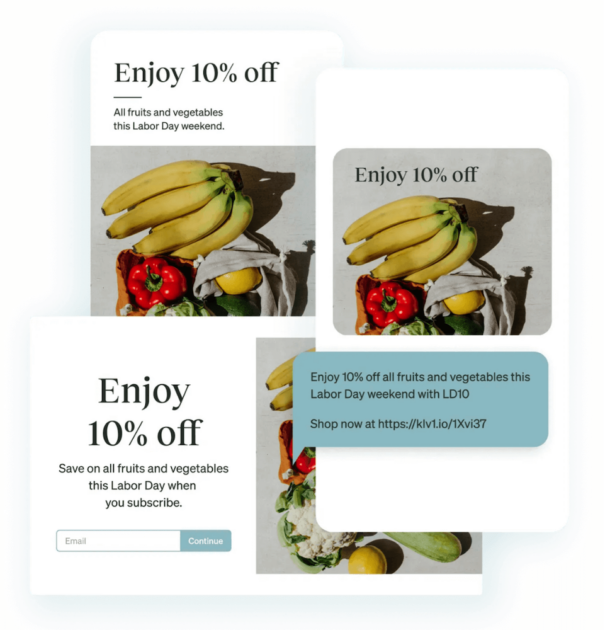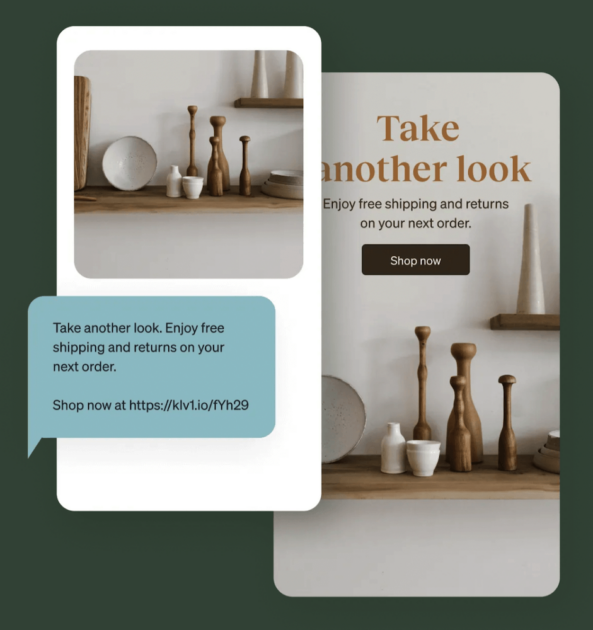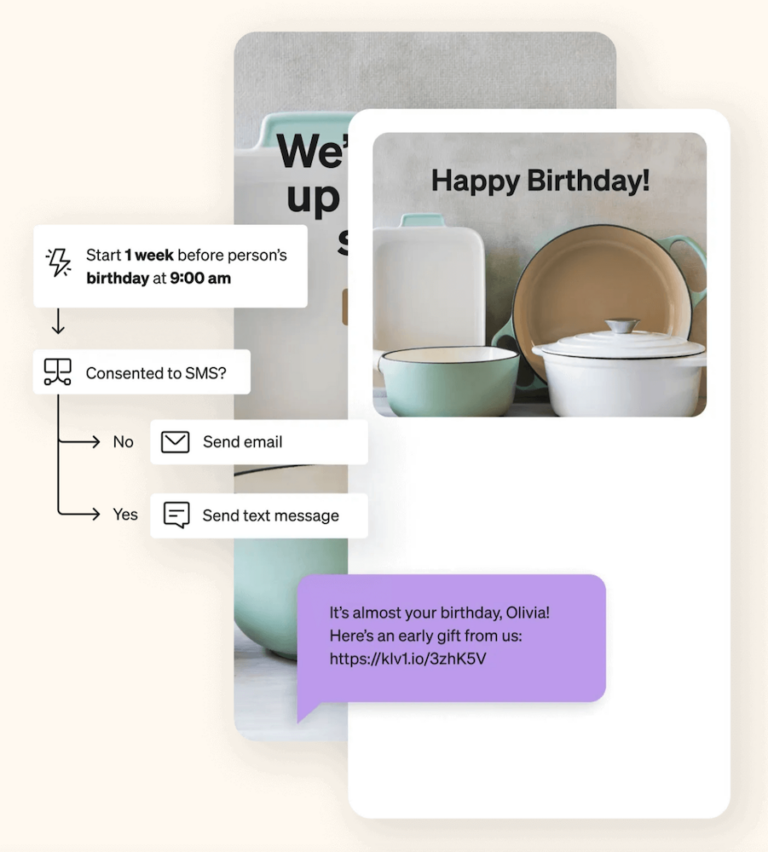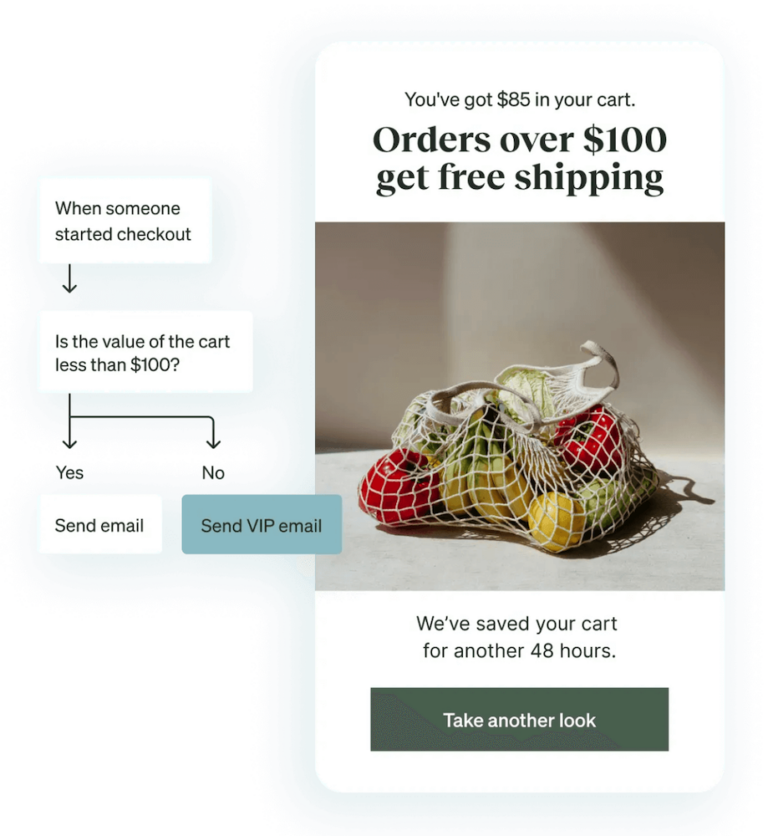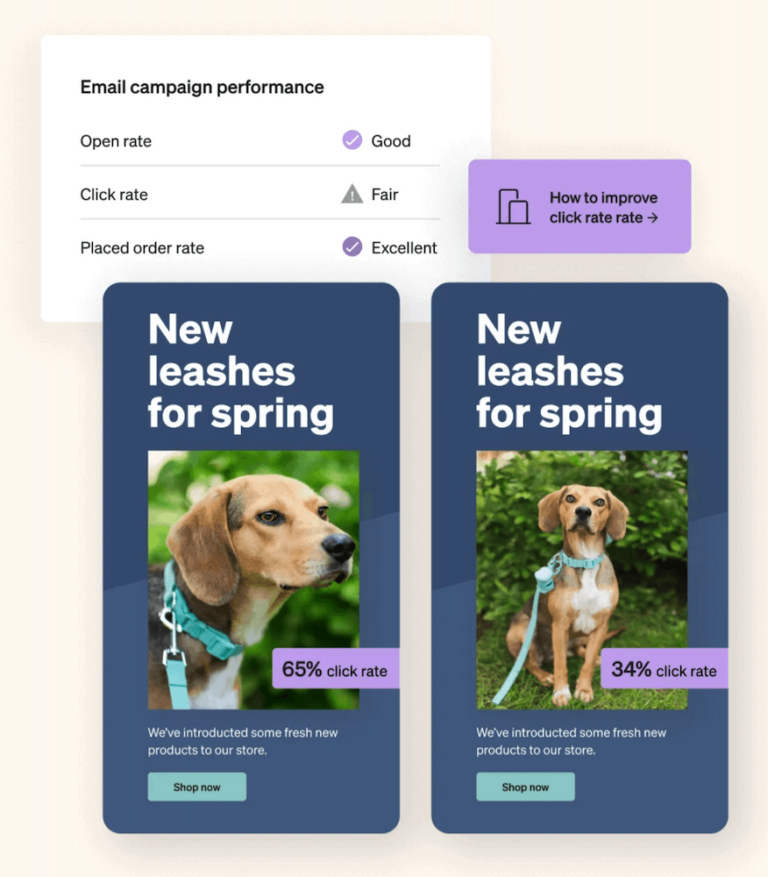
The advanced marketing automation guide: how fast-growing brands automate to scale
Successful marketing automation not only streamlines workflows and marketing tasks and maximizes your team’s efficiency. It also helps you better understand your customers and prospects, and improves those relationships by surfacing more relevant content for them, precisely when they’re most likely to act on it.
Introduction
Let's get automating
Here’s an example of marketing automation done wrong: Imagine you order a pair of hiking boots from your favorite outdoor apparel store. A few hours later, you get an email in your inbox: “Leave something behind?” The email includes a photo of the hiking boots you just purchased.
Worst-case scenario, you’re confused and worried that something’s amiss with your order. Now you have to call customer service to investigate.
Best-case scenario, you understand your favorite outdoor apparel store set up the triggers or filters in their marketing automations incorrectly. Now you’re annoyed, and you’re less likely to open emails from them in the future.
Lindsey Murray, VP of performance marketing at leading digital customer experience company Blue Acorn iCi, sees this kind of thing all the time, even from “big brands that you would think have their stuff together.”
It’s a perfect example of how, done wrong, marketing automation has the potential to alienate customers—and lose you business.
Imagine if, instead of receiving an erroneous abandoned cart email, you got one featuring product recommendations related to the hiking boots you just bought—a quick-drying towel for your next camping trip, or winter-proof socks, or an extra pair of laces. Or maybe you get a plain-text email thanking you for your last few orders and offering you free shipping on your next one in recognition of your loyalty.
At its most basic level, marketing automation refers to technology that manages, schedules, and executes marketing processes and campaigns, automatically, by applying if/then logic to prospect and customer behavior.
Done right, it allows your business to use hyper-targeted, behavior-triggered email and SMS messages to reach the right people, grow your list, and drive more repeat sales at higher cart values.
Successful marketing automation not only streamlines workflows and marketing tasks and maximizes your team’s efficiency. It also helps you better understand your customers and prospects, and improves those relationships by surfacing more relevant content for them, precisely when they’re most likely to act on it.
Chris Gordon, head of client success at leading ecommerce and marketing agency Noticed, puts it simply: “Marketing automation, to me, is speaking to the right customer, at the right time, with the right messaging.”
Read on to learn:
- 4 reasons to use marketing automation at your ecommerce business
- Before you begin: how to lay a strong foundation for marketing automation
- 4 must-have email automations to implement today
- 3 smart ways to round out your marketing automation efforts
- How to measure the success of your marketing automations—and then improve them
- Final thoughts: “we don’t want to creep anybody out”
Welcome to your end-to-end guide to marketing automation for ecommerce businesses, written with contributions from our partners.



4 reasons ecommerce brands use marketing automation
Before we explore which marketing automations are most powerful for ecommerce brands, let’s take a look at 4 of the biggest problems marketing automation can solve for your brand:
According to McKinsey & Company, 71% of consumers expect personalization from the brands they interact with—and even more (76%) get frustrated when they don’t get it.
That means in order to build credibility with consumers, your marketing can’t just be the smartest or the sexiest or the most engaging.
With so many marketing messages out there that check all those boxes, what your marketing efforts should aim to be, above any other adjective, is relevant—a word whose meaning may change drastically from individual to individual.
Enter: marketing automation.
Because automated marketing is based on unique customer data, “it’s great from a customer perspective—the experience is inherently tailored specifically to every customer,” explains Sean Donahue, director of email marketing at nationally recognized digital marketing agency Power Digital.
The explicit goal of marketing automation, Gordon says, “is to make the marketing experience more personalized. You want to make it feel as much as possible like a customer picked up a product in your store and a sales associate came over to talk to them about it.”
It works, too: McKinsey also reports that companies that excel at personalization in marketing generate 40% more revenue from related activities than average players.
“It’s 2022. It’s the new gold standard to have personalization,” Donahue says. “If you’re not sending messages on a 1:1 level, you’re doing it wrong.”
Before you begin: how to lay a strong foundation for marketing automation
Marketing automation looks different for every business, but one thing is true across the board: It’s not something you can do by the seat of your pants.
In marketing, minimum viable product has its time and place—or, let’s be honest, lots of times and places.
This isn’t one of them. When it comes to marketing automation, “you definitely have to be thoughtful,” Donahue advises.
Here’s what to keep in mind about selecting marketing automation technology and determining your marketing automation strategy, before you start digging in and setting up your automations.
The data, the tech, and the strategy
When evaluating your marketing automation technology options, experts agree one consideration should be paramount above all others: data integration. “That’s definitely the biggie,” Browne says. “If you don’t have the data, it’s all worthless.”
“Most ESPs provide great single-click integrations for ecommerce platforms, but it’s critical to understand what vendors and partners a brand works with and how much lift it’s going to take to get that data into the platform,” Donahue agrees. “The biggest challenge is getting your data in place and making sure you have what you need set up ahead of time.”
That’s because quality marketing automation depends, largely, on quality data, and the sophistication of the technology that gives you access to it. It’s not just about understanding your audience as a whole—it’s also about understanding various groups, or segments, of customers, based on:
- Where they’re located
- How old they are
- What they’ve bought, or almost bought
- How they’re engaging with your emails, texts, and website
- The shopping and personal preferences they’ve shared with you
- …and more
Donahue calls it “smart data”: largely behavioral data that’s clean, stored in a consistent format, and as up to date as possible.
“With marketing automation, the event triggering and the message launching is all happening in near real time,” he explains. “You need to make sure that data is there to back that up.”
Whether it’s your shipping platform, your order management system, your customer relationship management tool (CRM software), your project management system, your helpdesk provider, or all of the above plus more, it’s absolutely critical to make sure your marketing automation platform integrates seamlessly with the rest of your tech stack.
“The data drives everything,” Donahue emphasizes. “Your personalization, your recommendations, I mean, you name it for content within a message, it’s all being delivered based on the data being sent to the platform.”
Klaviyo’s 200+ data integrations work seamlessly with the tools you use to run your business every day. Here are just a few of the one-click integrations available with Klaviyo:
- Shopify and Shopify Plus
- Magento
- WooCommerce
- Wix
- Gorgias
- Aftership
- Okendo
- Recharge
How smart data drives sophisticated segmentation in Klaviyo
Gordon calls Klaviyo’s one-click integrations “rock-solid”—they’re what enables the marketing automation solution’s “really, really strong segmentation capabilities,” he says.
“They allow you to segment off of all the data points you’d want—any sort of data that comes directly from engagement with your marketing, but also any of the platforms you’re using.”
“We can get super granular with it,” Gordon adds. He cites a client that sells sports hats in explaining the importance of smart data when it comes to not alienating customers.
“Let’s say you’ve bought or viewed Yankee products in the past and the Yankees just won the World Series—we’ll send you this celebratory email,” Gordon explains. “If you bought or viewed Red Sox stuff in the past, we will not send you that email.”
Murray and Browne recall one project involving customers in 13 different locales, where “every flow we created had 13 variations of language and currency,” Murray says (“flow” is Klaviyo’s word for “automation”). “It was a lot of conditional splits, with a lot of show- and hide-type blocks based on profile variables.”
Those variables included everything from the basics, like whether or not someone was subscribed to email and SMS, to populating specific content based on a customer’s zip code or past purchase behavior, to delivering different welcome emails based on whether a customer signed up in store or online.
In Klaviyo, “you can split based on just about anything you can think of,” Gordon says. “The sky is really the limit. You can just keep getting more and more granular as long as it makes sense, and as long as there are enough customers in that segment of people to make the juice worth the squeeze.”
Can’t we just mix and match different point solutions?
Not really. A good marketing automation tool not only collects all this data, but also stores it in one place for easy access—allowing you to develop a complex, 360-degree view of each customer that evolves over time alongside their wants, needs, and behaviors.
If your marketing automation software’s data integrations aren’t up to that kind of task, Murray cautions, “make sure you have a development team or a tech team that’s going to be able to support you in that role.”
It’s a lesson she and Browne learned from experience: “Eons ago, when we were operating on a custom platform, nothing integrated with us,” she recalls. “The marketing tools we used had all these amazing capabilities, but if you don’t have all of the inputs and the data flowing properly, you can’t leverage them.”
Without a marketing automation platform like Klaviyo, which houses all your customer data in the same place where your email and SMS automations live, “it would be really difficult to personalize and automate messaging specific to each customer,” Murray explains. “Otherwise you’re dealing with all this disparate data and trying to export different lists of people who meet certain criteria, and it’s just a nightmare.”
“You accomplish so little just to keep the lights on,” Murray adds. “And then you spend all your time doing things that are mindless. The whole point of marketing automation is you don’t have to focus on those mindless tasks. You get to focus on what actually moves the needle.”
4 must-have email marketing automations to implement today
Marketing automation looks different for every business, but agency experts tend to agree on the “absolute essentials,” as Donahue puts it—the core automations “you must have in order to get off the ground” and achieve true omnichannel engagement with your customers.
“It’s all about prioritization,” Gordon says. “Make sure your basics are there to start with, and then you can swing back around later to make everything as good as it can possibly be.”
In Klaviyo, Gordon says getting started with automations is “very easy and scalable” with a little practice. “They’re easy to turn on because Klaviyo makes them easy to turn on,” Murray agrees.
Here are the 4 core email automations that are absolute must-haves for every business.
The core 4 automations, according to experts
Your welcome series is usually the first email interaction you have with a prospect or customer. Because these emails capitalize on new subscriber enthusiasm, they tend to have high open rates—more than half of subscribers open an email in a welcome series, according to Klaviyo’s Q222 email marketing benchmarks.
That means “there’s a lot of opportunity within a welcome series to build initial trust,” Donahue points out. “That is your first introduction to that contact, so you really need to make sure you’re building that brand sentiment and awareness, and giving them a full understanding of what your brand is all about.”
Whether you build out the components of your welcome email to tell a story about what sets your brand apart from others in your industry, introduce your best-selling products, offer a discount for a first purchase, or promote your social media channels, “you’ve got to have a welcome series live right from the start,” Gordon says.
Pro tip: While the welcome series is a prime opportunity to build brand affinity, there’s plenty of opportunity to earn some serious cash, here, too. Gordon says his first question when a customer signs up to receive emails from a brand is, “OK, now how do we convert them?”
Considering welcome flows come in second behind abandoned cart flows for highest average click rate, conversion rate, and revenue per recipient (5.88%, 1.95%, and $1.99, respectively), that could be an important—and lucrative—lens to look through when setting up these automations.
“Your welcome series is where you want to give your best sales pitch,” Gordon explains. “You let them know the brand story, you build their trust with reviews and testimonials, you show the products in the best light, you introduce the entire product line, and you try to provide as many shopping opportunities as possible.”
Be intentional, too, about where you’re driving welcome series traffic, Gordon advises: “It’s one thing to land someone on a homepage, but if you could land them on a product they’re already interested in within the email, that gets you that much closer to an add-to-cart event.”
How to set up a welcome series automation in Klaviyo
Visit our help center to learn:
- How contacts are added to a list
- The difference between double vs. single opt-in lists
- How to adapt Klaviyo’s standard welcome flow for your purposes
- How to build a welcome flow from scratch
- How to time your welcome series
- How many emails to include in your welcome series
- What content to include in your welcome series
- How to target based on factors like:
- Zero-party data like hair type
- Subscribers who have never made a purchase
- Subscribers who haven’t purchased since signing up
3 smart ways to round out your marketing automation efforts
Marketing automation works best when you think of it as an ecosystem, Gordon explains: “The way you build content into your flows can help feed the machine of the other flows. They all kind of support each other.”
Here’s an example: A shopper views a few products on your website but doesn’t add any to their cart or start the check-out process. So they get a browse abandonment email that shows them personalized product recommendations based on the products they were browsing earlier, because “maybe they were looking for something similar but not quite,” Gordon points out.
The browse abandonment email leads the shopper back to the site, and this time they place an item in their cart. But they still don’t check out. Maybe they got distracted by a phone call, or maybe they just need to see the product again. A few hours later, they receive an abandoned cart email, and that’s what finally drives them to purchase.
A few weeks after their purchase, once the product has been delivered and the customer has had a chance to experience it, they receive a thank-you email offering a discount or free gift in exchange for leaving a review. Later, that customer review is used as social proof in the welcome series that introduces other new customers to the brand.
All of this allows a marketing automation platform like Klaviyo to collect the kind of Customer-First Data™ that drives powerful marketing efforts over time, Gordon points out: “Every time a customer reaches a product page, Klaviyo collects that data, giving us the opportunity to follow up with another flow and continue bringing the customer further down the funnel to a product that they might be more interested in.”
Once your 4 core marketing automations are ready to rock, here are a few other ways you can maximize your marketing automation efforts to “feed the machine,” as Gordon says—and keep customers feeling seen and satisfied over time.
Maximize your marketing automation efforts
Like apps, there’s pretty much an email marketing automation for everything. Here are just a few of the ones experts recommend you get up and running once you’ve got a solid foundation:
Up- and cross-sell email automations
This might mean a “category affinity” email—“an after-the-fact cross-sell where we look at whether this customer has made multiple purchases from this category in X number of weeks or months,” Gordon explains. “Then, we identify them as a customer who is into that type of product and would be interested in purchasing variants on that product.”
An up- or cross-sell automation might also fall into the realm of “complete the set-up,” Gordon says, which is more about showing shoppers products in different categories that may complement what they already have.
Either way, the success of this type of automation depends entirely on the quality of your data.
“I might know that if someone buys this kind of t-shirt, they’re more likely to buy this kind of hat,” Donahue explains. “So somebody’s already purchased, but now I’m showing them this other product that maybe they hadn’t thought of. It’s now right in front of them—the opportunity is presented. Big revenue driver there.”
Pro tip: Don’t underestimate the power of the bounce-back buy, Gordon advises.
“Sometimes it makes sense to provide other shopping opportunities shortly after the initial purchase,” he suggests. “I’m not personally somebody who buys something online and then buys something again right away, but it happens all the time, especially if you offer free shipping.”
As long as you have the data to prove it’s something your customers want, “those kinds of up-sell opportunities, even right after someone already bought, can be very important,” Gordon says. “Those are typically top performers for the brands we set them up for.”
“Faux loyalty” email automations
If you use sign-up forms or quizzes on your website to gather zero-party customer data, you can ask subscribers to share their birthdays—and set up emails to auto-send when the date arrives, offering a birthday discount or free gift or simply acknowledging the moment.
Browne calls these kinds of emails “faux loyalty flows.” For brands that either aren’t ready or don’t have the funds to invest in an official loyalty program, birthday emails or messages celebrating the anniversary of someone’s first purchase can go a long way in making customers feel special.
Gordon notes that Klaviyo makes it easy to set up conditional splits based on customer data, such as “instances where VIP customers get a different deal,” or splitting based on CLTV, number of purchases, and more.
All of those strategies can go a long way in fostering a sense of exclusivity among your customers. “We try to be scrappy and stretch our dollars as much as we can,” Browne adds. “Klaviyo allows us to do that.”
Pro tip: If you ask for the year, not just the month and the day, you can use the birthday data you collect in future segmentation efforts for marketing based on generational shopping preferences.
Replenishment email automations
If you sell products that buyers need to restock regularly, such as facial creams or coffee pods, replenishment flows are a great way to ensure your customers don’t forget to reorder when they’re about to run out—and end up buying from the convenience store down the street because they’ve run out of time to wait.
“If it’s not right in front of my face, I’m probably not going to remember to go buy that thing,” Donahue points out. In Klaviyo, “we’re able to calculate, based on the data we have for sales, how often a customer is going to need that product, and then auto-send that reminder that literally gives them an easy button in their inbox.”
Pro tip: You can certainly set up a replenishment automation based on the time it takes the average customer to work their way through a month’s supply of coffee pods.
But even if your brand doesn’t sell CPG items, you can still take advantage of a replenishment-style flow by leaning on Klaviyo’s predictive analytics to estimate when a customer is most likely to purchase again—and not necessarily the exact same item.
Gordon calls these types of flows “repeat purchase nurtures” because they send “whenever we expect you to make your next purchase,” he explains.
Back-in-stock marketing automations
In light of ongoing supply chain issues, “there’s a lot of money being left on the table if you aren’t taking advantage of back-in-stock flows,” Donahue warns.
With back-in-stock automations, which send automatically to customers who sign up to learn when a specific item becomes available again, you can make sure you never miss out on a sale—even if you’re facing inventory shortages.
Pro tip: When setting these up, make sure you include minimum inventory rules post-restock. You don’t want to send 100 customers a message that says, “Look what’s back—want to buy it?” if 90 of them might end up disappointed and frustrated, thinking, “I wish I could.”
With flash sales, especially, “things can go out of stock very quickly,” Browne cautions. “If you send an email promoting an out-of-stock product, that’s a huge inconvenience for the consumer.”
Win-back email automations
What if a customer doesn’t buy when you expect them to buy—or, worse, stops interacting with your brand altogether?
As long as they haven’t unsubscribed from your marketing, you might be able to reach them with a win-back email: “our attempt at saving you from churning and never buying from us again,” Gordon explains.
A win-back email is an automation targeting inactive subscribers, or customers who have made a purchase, clicked on an email, or visited your website in the past, but not recently. What constitutes an “inactive subscriber” depends entirely on your product lifecycle, but it generally means 3-6 months without engagement.
Pro tip: In Klaviyo, you can set up conditional splits based on the recency of your customer interactions. “If a customer has bought in the past, but it’s been a while, you can give them a different offer than you might give someone who’s never purchased,” Gordon points out.
This type of shopper is “a worthwhile customer to get back because you know they’ve spent money with you already,” Gordon explains. Try wooing them with a discount, free shipping offer, or other incentive.
How to set up supplementary flows in Klaviyo
How to measure the success of your marketing automations—and then improve them
Now that you’ve got your marketing automations up and running, they should pretty much work on their own. But that doesn’t mean you can forget about them forever. “I don’t know if we’ve ever reached a place where we just stop and say, ‘OK that’s it,’” Donahue says.
“We’re of course being mindful as we set it up, but then we also run optimizations to make sure that the engagement we’re getting says this is the right thing to do,” Donahue adds. “And then we act accordingly. If we see things aren’t working, we tweak that in any number of ways and continue to drive in that direction.”
How, exactly? Here are 3 ways to test and optimize your marketing automations in Klaviyo.
Iterate and optimize
In order to understand whether your automations are doing what you need them to do, you first need to know what you’re looking for.
“We review the data—the results and the benchmarks we have available within Klaviyo—and the data speaks to us,” Donahue says. “We’re then able to use that data to figure out where to pivot.”
Experts agree that key KPIs for marketing automations “depend on the business, the flow, and the goal of the flow,” as Gordon says.
Overall, though, Murray, Browne, and Donahue recommend marketers pay attention to the following engagement metrics when evaluating whether their marketing automations are working:
- Open rate
- Click-through rate
- Conversion rate
- ROI
- Deliverability
- Unsubscribes
While “conversions are always top of mind,” Gordon says, he actually pays more attention to clicks.
“In the school of thought I come from, we tend to think that the job of the email is to get the customer onto the site, ready to buy, and then it’s the site’s job to convert that customer,” he explains. “So the email should be trying to drive just as much traffic as humanly possible to the site, and then hopefully the site converts them from there.”
If your automations are earning big-time clicks but new subscribers are not converting, for example, “maybe you need to look at your homepage or the landing page you’re driving traffic to,” Gordon suggests. “Look at core KPIs across your overarching data, even outside of email.”
Understanding automation analytics in Klaviyo
Visit our help center to learn about:
- The 30-day analytics snapshot
- Analytics on the visual canvas
- The flow message overview report
- Reviewing recipient activity
- Reviewing link activity
- Advanced reporting
Final thoughts
“We don’t want to creep anybody out”
OK, we’ve seen how powerful marketing automation can be when you do it right, and what you can line up to make sure you’re approaching it from the right angles. The biggest challenge now, experts agree, is finding the right balance—in other words, “boundaries,” Murray says.
“We know how beneficial all these automations are, but you don’t want to overwhelm your customer, either,” Browne points out. “This comes back to the fact that you need to know your customer—whether they’re email or SMS people, how often they like to be talked to, what’s too much, etc.”
What’s too much—and also what’s alarming. As Donahue points out, we’ve all had that moment after having a casual conversation when we open our phones, start scrolling, and immediately see an advertisement for the exact thing we were just talking about.
“We don’t want to reflect that in email marketing,” Donahue emphasizes. “We don’t want to creep anybody out. So how do we do all of this, and make it a really personalized experience, without coming across as Big Brother?”
As with so many things in marketing automation, the answer lies in the data. “If we see an increase in unsubscribe rates, or a decrease in engagement overall, it would be time to reassess the overall customer journey strategy and quantity of campaigns and flows,” Browne explains.
“Engagement tells us everything we need to know,” Donahue agrees. “If we’re getting too close to the sun with personalization, that is absolutely going to reflect in the data and we’ll know to back off.”
If you’re struggling to strike the right balance, remember that the ultimate goal of marketing automation, Donahue says, is to “give the customer value.”
“Be helpful,” Donahue says. “Be there for the customer when they need you, and not when they don’t. Marketing automation is about finding those opportunities—making sure you’re in the right place at the right time, and not where you shouldn’t be.”




